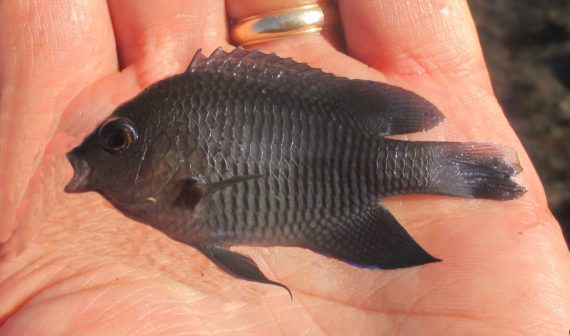Whitetail Damselfish, Stegastes leucorus
 Whitetail Damselfish, Stegastes leucorus. Fish caught out of a tidal pool from coastal waters of Mazatlán, Sinaloa, April 2015. Length: 6.4 cm (2.5 inches). Catch and photograph courtesy of George Brinkman, Guelph, Ontario, Canada.
Whitetail Damselfish, Stegastes leucorus. Fish caught out of a tidal pool from coastal waters of Mazatlán, Sinaloa, April 2015. Length: 6.4 cm (2.5 inches). Catch and photograph courtesy of George Brinkman, Guelph, Ontario, Canada.
 Whitetail Damselfish, Stegastes leucorus. Fish caught from coastal waters off Acapulco, Guerrero, February 2017. Length: 12.8 cm (5.0 inches). Catch and photograph courtesy of Ben Cantrell, Peoria, Illinois.
Whitetail Damselfish, Stegastes leucorus. Fish caught from coastal waters off Acapulco, Guerrero, February 2017. Length: 12.8 cm (5.0 inches). Catch and photograph courtesy of Ben Cantrell, Peoria, Illinois.
 Whitetail Damselfish, Stegastes leucorus. Underwater photographs taken in coastal waters of the greater Los Cabos area, Baja California Sur, May 2018. Photographs courtesy of Bob Hillis, Ivins, Utah.
Whitetail Damselfish, Stegastes leucorus. Underwater photographs taken in coastal waters of the greater Los Cabos area, Baja California Sur, May 2018. Photographs courtesy of Bob Hillis, Ivins, Utah.
The Whitetail Damselfish, Stegastes leucorus, is a member of the Damselfish or Pomacentridae Family, and is known in Mexico as jaqueta rabi blanco. Globally, there are forty species in the genus Stegastes, of which eleven are found in Mexican waters, seven in the Atlantic and four in the Pacific Ocean.
The Whitetail Damselfish has an oval compressed body with a depth that is 42% to 46% of standard length, thus similar in nature to freshwater bluegills. The adults have deeper bodies than the juveniles. Adults are dark brown in color with darker outlines on their scales. Most adults have a subtle white band on their caudal fin after which they are named. The iris of their eyes is blue. They have a narrow blue band on the margin of their anal fin (a key to the identification) and a white margin on their pectoral fins. Juveniles are dark with an olive-green tinge and have a dark ocellus at the rear base of their dorsal fin and a broad white bar across their caudal base. Their head has a small protrusible mouth that opens in the front with a single row of long and closely set teeth. Their anal fin has 2 spines and 12 or 13 rays; their caudal fin is bluntly forked; and their dorsal fin is singular and continuous with 12 spines and 14 to 16 rays. They have 10 to 12 gill rakers on their lower arch. Their body is covered with large rough scales. Their lateral line is incomplete and ends under the edge of their dorsal fin base.
The Whitetail Damselfish is found in shallow reefs within the surge zone at depths up to 18 m (60 feet). They reach a maximum of 17.0 cm (6.7 inches) in length. They are diurnal feeders consuming primarily algae, benthic invertebrates and plankton. They are very aggressive with their feeding habits and when defending their territory. Reproduction is oviparous with pairing of individuals; eggs are distributed demersal and adhere to the substrate due to their stickiness. The Whitetail Damselfish is poorly studied with very limited information available about their lifestyle and behavioral patterns including specific details on age, growth, longevity, movement patterns, diet, habitat use, and reproduction.
The Whitetail Damselfish is a resident of Mexican waters of the Pacific Ocean but has limited and poorly documented range being found only along the extreme northwest coast of Baja, around the southeast tip of Baja, and in and around the greater Mazatlán, Sinaloa area. The second photo below extends the known range for this species.
The Whitetail can easily be confused with the Acapulco Damselfish, Stegastes acapulcoensis (front half of body lighter in color), the Beaubrummel, Stegastes flavilatus (yellow tip fins; 11 or 12 gill rakers on lower arch), and the Cortez Damselfish, Stegastes rectifraenum (white tip fins).
From a conservation perspective the Whitetail Damselfish is currently considered to be VULNERABLE as 90% of their population resides in the Revillagigedo Islands and they are uncommon in coastal waters. They are small in stature and of limited interest to most. They are classic nibblers, thus difficult to catch by hook and line.